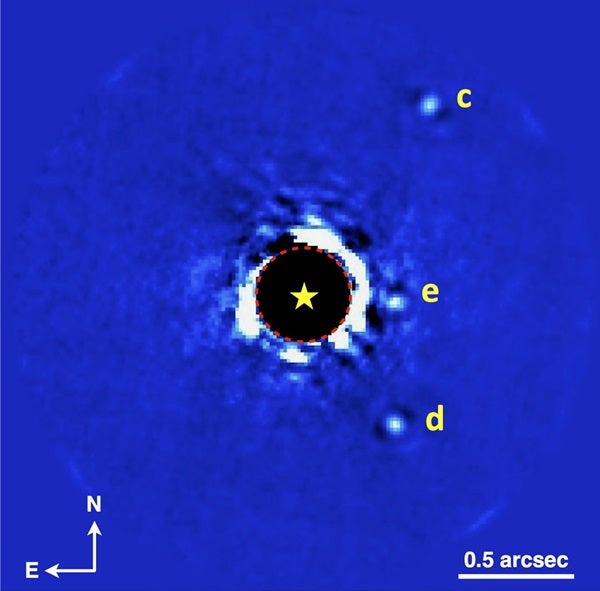Marshall Perrin from the Space Telescope Science Institute in Baltimore, Maryland, presented a pair of recent and promising results at a press conference. He revealed some of the most detailed images and spectra ever of the multiple planet system HR 8799. His presentation also included never-seen details in the dusty ring of the young star HR 4796A. “GPI’s advanced imaging capabilities have delivered exquisite images and data,” said Perrin. “These improved views are helping us piece together what’s going on around these stars, yet also posing many new questions.”
The GPI spectra obtained for two of the planetary members of the HR 8799 system presents a challenge for astronomers. GPI team member Patrick Ingraham from Stanford University in California reports that the shape of the spectra for the two planets differ more profoundly than expected based on their similar colors, indicating significant differences between the companions. “Current atmospheric models of exoplanets cannot fully explain the subtle differences in color that GPI has revealed. We infer that it may be differences in the coverage of the clouds or their composition,” Ingraham said. “The fact that GPI was able to extract new knowledge from these planets on the first commissioning run in such a short amount of time and in conditions that it was not even designed to work is a real testament to how revolutionary GPI will be to the field of exoplanets.”
Perrin, who is working to understand the dusty ring around the young star HR 4796A, said that the new GPI data present an unprecedented level of detail in studies of the ring’s polarized light: “GPI not only sees the disk more clearly than previous instruments, it also can measure how polarized its light appears, which has proven crucial in understanding its physical properties.”
Specifically, the GPI measurements of the ring show it must be partially opaque, implying it is far denser and more tightly compressed than similar dust found in the outskirts of our solar system, which is more diffuse. The ring circling HR 4796A is about twice the diameter of the planetary orbits in our solar system and its star about twice our Sun’s mass. “These data taken during GPI commissioning show how exquisitely well its polarization mode works for studying disks. Such observations are critical in advancing our understanding of all types and sizes of planetary systems and ultimately how unique our own solar system might be,” said Perrin.
During the commissioning phase, the GPI team observed a variety of targets, ranging from asteroids in our solar system to an old star near its death. Other teams of scientists have been using GPI as well, and astronomers around the world have published eight papers in peer-reviewed journals using GPI data. “This might be the most productive new instrument Gemini has ever had,” said James Graham of the University of California.
The Gemini Observatory staff integrated the complex instrument into the telescope’s software and helped characterize GPI’s performance. “Even though it’s so complicated, GPI now operates almost automatically,” said Fredrik Rantakyro for GPI. “This allows us to start routine science operations.” The instrument is now available to astronomers and their proposals are scheduled to start observing in early 2015. In addition, “shared risk” observations are already underway, which started in November 2014.
The one thing GPI hasn’t done yet is discover a new planet. “For the early tests, we concentrated on known planets or disks,” said GPI Bruce Macintosh. Now that GPI is fully operational, the search for new planets has begun. In addition to observations by astronomers worldwide, the Gemini Planet Imager Exoplanet Survey (GPIES) will look at 600 carefully selected stars over the next few years. GPI “sees” planets through the infrared light they emit when they’re young, so the GPIES team has assembled a list of the youngest and closest stars. So far the team has observed 50 stars and analysis of the data is ongoing. Discovering a planet requires confirmation observations to distinguish a true planet orbiting the target star from a distant star that happens to sneak into GPI’s field of view — a process that could take years with previous instruments. The GPIES team found one such object in their first survey run, but GPI observations were sensitive enough to almost immediately rule it out. Macintosh said, “With GPI, we can tell almost instantly that something isn’t a planet rather than months of uncertainty. We can get over our disappointment almost immediately. Now it’s time to find some real planets!”










